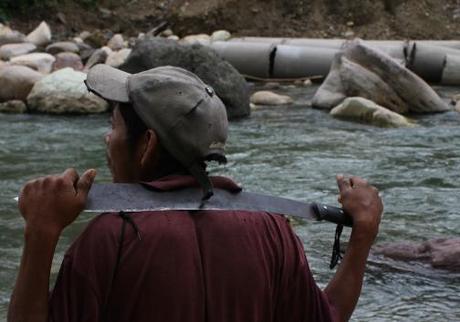
by Andrew Stefan / White Rose Reader
“No communities of people on this Earth have been more negatively impacted by the current global economic system than the world’s remaining 350 million indigenous peoples. And no people are so strenuously and, lately, successfully resisting these invasions and inroads”
—Jerry Mander, Paradigm Wars
Over the summer, I decided I would attempt to travel to the indigenous Lenca community of Rio Blanco, Honduras, after I read that one of its residents was assassinated for opposing a corporate dam project.
The victim was Tomas Garcia. He was leading a delegation of some 200-300 people across his own community when he was murdered on July 15, 2013—shot dead at close-range while attempting to deliver a message to companies building a hydroelectric dam on Lenca land. The shots were fired by the Honduran military, in the service of the dam companies. Garcia was unarmed, and two others were injured as a result of the shooting, including Garcia’s 17-year old son.
It’s a sickeningly familiar story at this point. Corporation colludes with the state to seize or otherwise exploit indigenous lands and resources. Indigenous peoples mount courageous resistance, facing off against some of the most powerful and barbarous forces in human history. In the name of modernity, capitalism, or simply profit, the corporate-state employs extreme violence to crush the resistance. Sometimes, against all odds, the indigenous resistance succeeds, protecting livelihoods and resources. Though more often, those involved in the effort are killed, maimed, displaced, or dispossessed—the survivors forced to take sweatshop jobs within the vast, grinding capitalist-marketplace after being robbed of their previous lifeways and lands. Variations of this same tale can be found in locations from Acapulco to the Niger Delta to Palestine. It’s worldwide, and its roots are deep.
Don’t be fooled. This is not a narrative of the glorious triumphs of modernity and capitalism. It is a narrative of genocide and ecocide, written by global capitalism against indigenous peoples and planet Earth. It is a grim story, full of violence, exploitation, and human suffering, but—like all campaigns of genocide—it is a story of resistance as well.
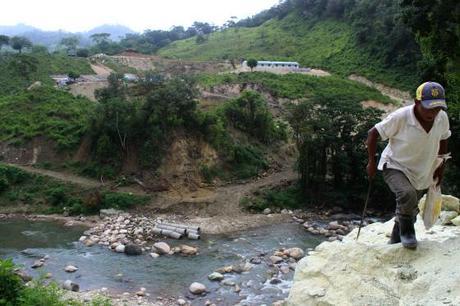
“Hundreds of yards down the mountain, I could see the river and the beginnings of the hydroelectric dam. Massive concrete tubes littered the riverbank.”
Rio Blanco constitutes an important frontline of that resistance. For generations, the people of the community have lived as subsistence farmers, on ancestral territory, growing crops such as beans, yucca, and coffee. Their land is well cared for, as it is needed for survival. The Gualcarque River, which runs along the edge of the community, is an obvious necessity for the people of Rio Blanco as well. Its pristine water is used for purposes ranging from drinking and cooking to crop irrigation—it is considered sacred. However, the relationship between community and river is being brought into question by DESA, a company seeking to privatize the water and construct a hydroelectric dam on the Gualcarque . If the dam is built, the people of Rio Blanco will lose access to the river, and perhaps even the very ground on which they live. Because so much is at stake, the Lenca residents of the area are willing to fight tooth-and-nail for their land. In the words of one young woman from the community: “If they take our river and our land, we will die. We are poor, and they are all we have. Here, we are struggling for our very lives and dignity. It is a fight against death.”
For the last seven months, the community has been obstructing the only main road in Rio Blanco, halting the dam’s construction for the time being. The blockade was implemented after years of attempts at resistance by the books—formal complaint filing, government town-hall meetings and community assemblies, peaceful protests—all to no avail. The system in Honduras, as it is everywhere, is rigged in favor of those with political power and money. The people of Rio Blanco are relatively deficient of both. Accordingly, DESA’s preparations for the construction of the dam megaproject are still underway, with full backing from the Honduran state. The community blockade was installed as a last line of defense against dispossession of land and livelihood.

“For the last seven months, the community has been obstructing the only main road in Rio Blanco, halting the dam’s construction for the time being.”
Serious repercussions have accompanied the effort. Since the blockade was established in early April, the corporate-state in Honduras has killed and maimed people involved with the action, such as Tomas Garcia. More recently, activists from the National Council of Popular and Indigenous Organizations of Honduras (COPINH) have been targeted for arrest and imprisonment, on bogus charges, for their collaboration with the people of Rio Blanco. The situation is bleak, but the resistance is finding more and more allies across the world as word of the struggle spreads.
When I arrived in Rio Blanco, I was greeted warmly by some forty people from the community—women, men, children, and elders—all complete strangers, on the sloping hillside of a wooded mountain. They took turns shaking my hand as we exchanged names. Within a few short minutes, I was handed a heaping bowl of pasta with tomato sauce and fresh fruit drink. I’ve always been amazed by the intense hospitality I’ve experienced in indigenous communities of Latin America. While I ate the pasta, I imagined for a moment how my hosts might be treated, as visitors, by the average person in my own country. Sickened, I shifted my focus back to the moment around me.
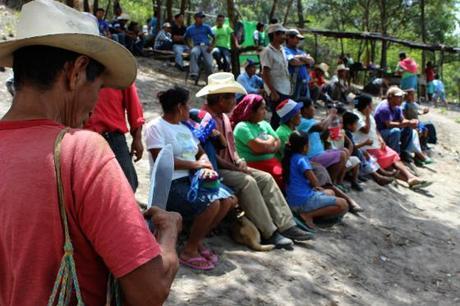
“The community convened a meeting—a sort of log-and-machete press conference—to share their stories with those of us who came to listen.”
The community convened a meeting—a sort of log-and-machete press conference—to share their stories with those of us who came to listen. What followed was an outpouring of emotion, conviction, and hard-hitting analysis. The discussions revolved around resisting the dam project, but also touched on the topics of the death of Tomas Garcia, and other struggles for social justice in Honduras and around the world. Lenca activist and COPINH coordinator Berta Cáceres spoke passionately, emphasizing the importance of international solidarity for the struggle in Rio Blanco. She is now wanted by the Honduran government, and in hiding.
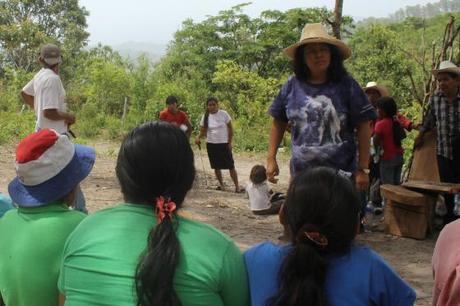
“Berta Cáceres spoke passionately, emphasizing the importance of international solidarity for the struggle in Rio Blanco.”
After the conference, some of the community members offered to drive the other visitors and me to the Gualcarque River. In the bed of a moving pickup truck, I stood, taking in the sights of a pristine mountain landscape covered with lush, dark-green foliage. After a few minutes on the road, the corporate buildings came into view and were pointed out by our guides. The truck drove slowly down a steep, dusty, dirt mountain path. Hundreds of yards down the mountain, I could see the river and the beginnings of the hydroelectric dam. Massive concrete tubes littered the riverbank. Looming above it all, on the opposite mountainside, a clear-cut section of forest was covered with construction machinery and scarred by some kind of crude barracks or compound.
We climbed out of the truck and edged down a part of the mountain covered with chalky boulders, toward the river. At the Gualcarque’s edge, the corporate debris looked doubly gross. Looking at certain sections of the river, one could infer how pristine the whole area had been prior to the corporate invasion.
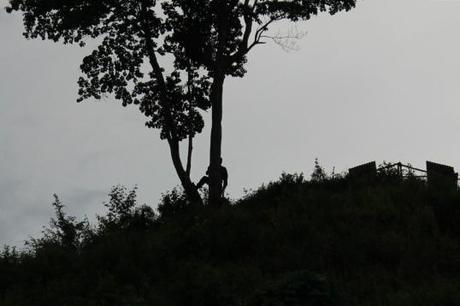
One of our guides approached me, pointed atop a hill on the other side of the river, and whispered, “Look, you can see the armed guards that patrol the compound up there—they carry shotguns.”
I looked up, squinting to see the silhouette of a man holding a long firearm. He was staring at us. As my eyes adjusted, it looked, for a moment, as though he was aiming the weapon at our group. My stomach sank and I immediately began to sweat while youths from the community jumped into the river, laughing. I thought back to the assassination of Tomas. My imagination was getting the best of me, but perhaps for good reason. I tried to fathom the anxiety that must follow having to use the river each day, with armed cretins glaring from above, ready to shoot and kill. However, if the people around me were anxious they sure weren’t showing it. They went about their business, collecting water, picking fruit, and playing in the river, as though nothing were wrong.
As noted by Jeff Conant in a recent article about Rio Blanco, “international solidarity is essential to protect the human rights of Hondurans.” To learn how you might be able to stand in solidarity with the people of Rio Blanco and other indigenous struggles around the world, visit the School of the Americas Watch web site. Also, be sure to sign an Avaaz petition demanding that President Porfirio Lobo drop the charges against Berta Cáceres and COPINH.

